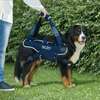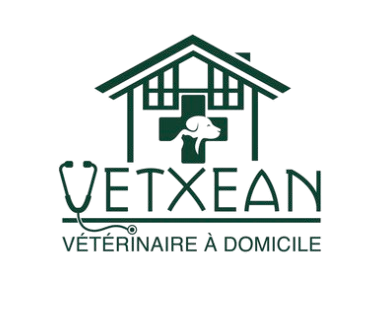7 interior design ideas to maintain your senior dog's quality of life
As with humans, our dogs' needs evolve with age. Understanding the challenges they face is crucial to adapting their environment and maintaining their daily comfort.
What simple changes can be made to your house/apartment to best help them?
1. Limit slips
What does it matter?
Our elderly companions are prone to arthritis and joint problems. This leads to a loss of grip, especially on smooth surfaces, with the associated stress and falls.
Simple solutions?
- Trimming the claws and sometimes the hair between the toes: obviously easier when your pet has been used to it since puppyhood, but don't hesitate to ask professionals (groomers or veterinarians) to help you. And if need be, a light tranquillization will enable me to do this during a consultation.

- Position non-slip mats: place mats on your companion's most frequent routes. Not only will this limit slips, but it will also provide comfort for their sometimes damaged paw pads and painful joints.

- ToeGrips® anti-slip aid for dogs: these are small rings placed on each claw to increase grip on hard, smooth or slippery floors.
I invite you to watch this impressive video on Mikan-vet.com, the reference in veterinary physiotherapy and rehabilitation.
There areanti-slip powders to be applied to the pads (PawFriction®), but these are not available in France.
As for non-slip boots, they encourage maceration between the toes. I would therefore advise against their use.
2. Easier access to bowls
What does it matter?
Bending or twisting can be painful for dogs suffering from osteoarthritis, muscle weakness or back pain.
Simple solutions?
- Place bowls high up: to reduce the need to bend down and thus neck and back pain. The height of the bowl should be adapted to the dog's size.


- Replace the water bowl with a water fountain. The water is fresher, stimulating your senior companion's drinking habits, as he may be more prone to kidney problems.
- Place a "peanut" ball under your dog's belly: for out-of-shape dogs who tend to slip when eating. Like yoga balls, some of these elongated balls can be used to support your companion while he eats.

3. Facilitating mobility for steps and staircases
What does it matter?
As dogs get older, climbing onto the sofa/bed or jumping into the car becomes increasingly complicated. Many senior dogs are initially reluctant to use the ramps provided, but with a little training (and treats!) they soon realize that it's less painful for them to use them.
Simple solutions?
- Ramps: there are many different models, some of them foldable for easy storage in the car. They are particularly interesting for large dogs.


- Harnesses: similarly, there are many types of harness that can support your dog when getting on or off. Preferably one with handles. If necessary, a bath sheet can do the trick.
(harness sold at mikan-vet.com)
4. The right bed for painful joints
What does it matter?
Older dogs spend much of their time sleeping. Proper bedding is essential to prevent bedsores.
Simple solutions?
- Orthopedic memory foam mattresses: reduce pressure on joints
- Baby mattresses: these can be a less expensive alternative for smaller dogs.
Remember to choose a mattress with a waterproof or washable cover
(orthopedic cushion sold at mikan-vet.com)

5. Adjusted brightness and temperature
What does it matter?
Senior dogs have difficulty regulating their body temperature and are prone to heat stroke. As they age, their vision diminishes in the dark.
Simple solutions?

- Hot water bottles: don't hesitate to add hot water bottles or auxiliary heaters in winter. Conversely, in summer, there are cooling mats to wet, to keep your companion cool.
(carpet sold at mikan-vet.com)
- Motion-sensor lights: position them on the "bed-hutch" paths to facilitate access at night and reduce your companion's anxiety.
- A baby monitor: not just the preserve of young parents, these can be useful for making sure your senior dog isn't in distress.
6. Facilitate access to "toilets
What does it matter?
Senior dogs can become messy, particularly due to osteoarthritis. To maintain their quality of life, but also to preserve the human-animal bond, it is essential to offer them immediate access to relieve their needs.
Simple solutions?
- A urinal in the house: this can be a puppy pad or a square of fake grass.
(Here is an example found on Amazon)

- Washable underpads or mats: to be placed in your dog's bed if he's incontinent, to keep him clean and dry at all times. The basket can be made of plastic, to protect the floor underneath in the event of an overflow.
7. Create quiet areas
What does it matter?
Anxiety increases with age, notably due to reduced sensory capacity (loss of sight, hearing, smell, etc.) and locomotor function (osteoarthritis).
Simple solutions?
- Quiet areas: make sure your dog has access to a quiet sleeping area, away from the noise and bustle of the house.
- Enriched with soothing objects: there are diffusers based on maternal pheromones (volatile maternal hormones) that calm your dog (e.g. Adaptil®). You can also use a white noise machine to mask the noise in the house.
As you can see, it's vital to be aware of your companion's needs, in order to maintain his or her quality of life. This can be preserved with a few interior improvements, but also by establishing a routine around meals, outings...
